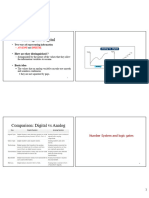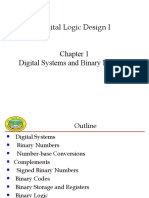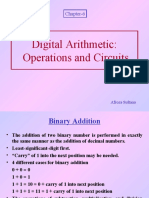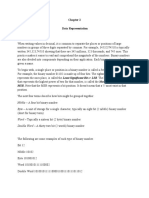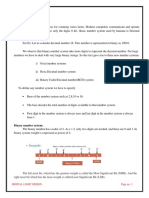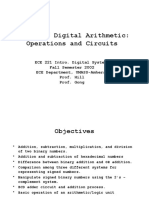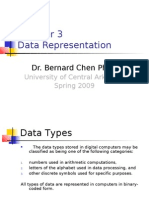LEARNING MODULE
Logic Design and Switching
Theory
1
� TABLE OF CONTENTS
I. Number System and Boolean Algebra and Switching Functions
Different number systems……………………………..4
Conversion Operations between different number system……...
Basic theorems and properties used in Boolean algebra…………
Designs different logic circuits using different logic gates………..
Designs multilevel realization functions………………………………
II. Minimization and Design of Combinational Circuits
Basic information in the design of combinational circuits
Solve and analyse Karnaugh Map
Designs Combinational multi-level circuits
Operation of Multiplexers and other arithmetic circuits
Can perform practical with combinational logic circuits
III. Sequential machines fundamentals
Identify architectural differences in combinational and sequential
circuits
Design sequential circuits for machine operation
Design Clocked flip flops
Makes use of timing and triggering circuits with sequential logics
2
�IV. Sequential circuit design and analysis
Draw state diagrams
Analyse synchronous sequential circuits
Designs sequential finite state machines
Designs different types of counters and registers
V. Sequential circuits and algorithmic state machines
Identify capabilities and limitations of finite state machine
Mealy and Moore minimization models
Partition techniques and merger chart methods
Concept of minimal cover table
3
� Lesson 1
Different number systems
Base-N Number System
Base N
N Digits: 0, 1, 2, 3, 4, 5, …, N-1
Example: 1045N
Positional Number System
N n 1 N 4 N 3 N 2 N 1 N 0
d n1 d 4 d3 d 2 d1 d 0
Digit do is the least significant digit (LSD).
Digit dn-1 is the most significant digit (MSD).
4
�Decimal Number System
Base 10
Ten Digits: 0, 1, 2, 3, 4, 5, 6, 7, 8, 9
Example: 104510
Positional Number System
10n1 104103102101100
d n1 d 4 d3 d 2 d1 d0
Digit d0 is the least significant digit (LSD).
Digit dn-1 is the most significant digit (MSD).
Binary Number System
Base 2
Two Digits: 0, 1
Example: 10101102
Positional Number System
Binary Digits are called Bits
Bit bo is the least significant bit (LSB).
Bit bn-1 is the most significant bit (MSB).
5
�Definitions
nybble = 4 bits
byte = 8 bits
(short) word = 2 bytes = 16 bits
(double) word = 4 bytes = 32 bits
(long) word = 8 bytes = 64 bits
1K (kilo or “kibi”) = 1,024
1M (mega or “mebi”) = (1K)*(1K) = 1,048,576
1G (giga or “gibi”) = (1K)*(1M) = 1,073,741,824
Hexadecimal Number System
Base 16
Sixteen Digits: 0,1,2,3,4,5,6,7,8,9,A,B,C,D,E,F
Example: EF5616
Positional Number System
6
�Binary Addition
Single Bit Addition Table
0+0=0
0+1=1
1+0=1
1 + 1 = 10 Note “carry”
Hex Addition
4-bit Addition
4+4=8
4+8=C
8+7=F
F + E = 1D Note “carry”
Hex Digit Addition Table
7
�1’s Complements
1’s complement (or Ones’ Complement)
To calculate the 1’s complement of a binary number just “flip” each
bit of the original binary number.
E.g. 0 1 , 1 0
01010100100 10101011011
Why choose 2’s complement?
2’s Complements
2’s complement
To calculate the 2’s complement just calculate the 1’s complement,
then add 1.
01010100100 10101011011 + 1=
10101011100
Handy Trick: Leave all of the least significant 0’s and first 1
unchanged, and then “flip” the bits for all other digits.
E.g. 01010100100 -> 10101011100
Complements
Note the 2’s complement of the 2’s complement is just the original
number N
EX: let N = 01010100100
8
� (2’s comp of N) = M = 10101011100
(2’s comp of M) = 01010100100 = N
Two’s Complement Representation for Signed Numbers
Let’s introduce a notation for negative digits:
For any digit d, define d = −d.
Notice that in binary, d+1=d , d̄+1=d
where d {0,1}, we have: 0+1=−0+1=1=0̄
Two’s complement notation: 1+1=−1+1=0=1̄
To encode a negative number, we implicitly negate the leftmost
(most significant) bit:
E.g., 1000 = (−1)000
= −1·23 + 0·22 + 0·21 + 0·20 = −8
Negating in Two’s Complement
Theorem: To negate
a two’s complement
number, just complement it and add 1.
−( X YZ 2 )=X YZ 2 +1
9
� Proof (for the case of 3-bit numbers XYZ):
−( X YZ 2 )=X YZ 2= X YZ 2 =( X̄ +1)YZ 2
¿ X̄ YZ2 +1002 = X̄ YZ+11 2+1
¿ X̄ (Y +1)( Z +1)2 +1
¿ X YZ2 +1
Signed Binary Numbers
Two methods:
First method: sign-magnitude
Use one bit to represent the sign
• 0 = positive, 1 = negative
Remaining bits are used to represent the magnitude
Range - (2n-1 – 1) to 2n-1 - 1
where n=number of digits
Example: Let n=4: Range is –7 to 7 or
1111 to 0111
Second method: Two’s-complement
Use the 2’s complement of N to represent
-N
Note: MSB is 0 if positive and 1 if negative
Range - 2n-1 to 2n-1 -1
where n=number of digits
Example: Let n=4: Range is –8 to 7
Or 1000 to 0111
10
�Signed Numbers – 4-bit example
Decimal 2’s comp Sign-Mag
7 0111 0111
6 0110 0110
5 0101 0101
4 0100 0100
3 0011 0011
2 0010 0010
1 0001 0001
0 0000 0000
Signed Numbers-4 bit example
Decimal 2’s comp Sign-Mag
-8 1000 N/A
-7 1001 1111
-6 1010 1110
-5 1011 1101
-4 1100 1100
-3 1101 1011
-2 1110 1010
-1 1111 1001
-0 0000 (= +0) 1000
11
�Signed Numbers-8 bit example
Notes:
“Humans” normally use sign-magnitude representation for signed
numbers
E.g.: Positive numbers: +N or N
Negative numbers: -N
Computers generally use two’s-complement representation for
signed numbers
First bit still indicates positive or negative.
If the number is negative, take 2’s complement to determine its
magnitude
Or, just add up the values of bits at their positions,
remembering that the first bit is implicitly negative.
Examples
Let N=4: two’s-complement
What is the decimal equivalent of
01012
Since MSB is 0, number is positive
01012 = 4+1 = +510
What is the decimal equivalent of
11012 =
Since MSB is one, number is negative
Must calculate its 2’s complement
11012 = − (0010+1) = − 00112 or −310
12
�Arithmetic Subtraction
Borrow Method
This is the technique you learned in grade school
For binary numbers, we have
0–0=0
1–0=1
1–1=0
1
0–1=1 with a “borrow”
Binary Subtraction
A – (+B) = A + (-B)
A – (-B) = A + (-(-B))= A + (+B)
In other words, we can “subtract” B from A by “adding” –B to A.
However, -B is just the 2’s complement of B, so to perform
subtraction, we
1. Calculate the 2’s complement of B
2. Add A + (-B)
Example
Let n=4, A=01002 (410), and
B=00102 (210)
Let’s find A+B, A-B and B-A
A+B 0 1 0 0 (4)10
+ 0 0 1 0 (2)10
=0110 6
A-B 0 1 0 0 (4)10
- 0 0 1 0 (2)10
13
� A + (-B) 0 1 0 0 (4)10
+ 1 1 1 0 (-2)10
=1 0 0 1 0 2
“Throw this bit” away since n=4
B-A 0 0 1 0 (2)10
- 0 1 0 0 (4)10
B + (-A) 0 0 1 0 (2)10
+ 1 1 0 0 (-4)10
1110 -2
1 1 1 02 = - 0 0 1 02 = -210
“16’s Complement” method
The 16’s complement of a 16 bit Hexadecimal number is just:
=1000016 – N16
Q: What is the decimal equivalent of B2CE16 ?
Since sign bit is one, number is negative. Must calculate the 16’s
complement to find magnitude.
1000016 – B2CE16 = ?
We have
10000
- B2CE
FFF10
- B2CE
=4D32
So,
1000016 – B2CE16 = 4D3216
= 4×4,096 + 13×256 + 3×16 + 2
14
� = 19,76210
Thus, B2CE16 (in signed-magnitude)
represents -19,76210.
Sign Extension
Assume a signed binary system
Let A = 0101 (4 bits) and B = 010 (3 bits)
What is A+B?
To add these two values we need A and B to be of the same bit
width.
Do we truncate A to 3 bits or add an additional bit to B?
A = 0101 and B=010
Can’t truncate A! Why?
A: 0101 -> 101
But 0101 <> 101 in a signed system
0101 = +5
101 = -3
Why does sign extension work?
Note that:
(−1) = 1 = 11 = 111 = 1111 = 111…1
Thus, any number of leading 1’s is equivalent, so long as the
leftmost one of them is implicitly negative.
Proof:
111…1 = −(111…1) =
= −(100…0 − 11…1) = −(1)
So, the combined value of any sequence of leading ones is always just
−1 times the position value of the rightmost 1 in the sequence.
111…100…0 = (−1)·2n
15
�Decimal to Binary Conversion
Method I:
Use repeated subtraction.
Subtract largest power of 2, then next largest, etc.
Powers of 2: 1, 2, 4, 8, 16, 32, 64, 128, 256, 512, 1024, 2n
Exponent: 0, 1, 2, 3, 4, 5, 6, 7, 8, 9, 10 , n
20 21 22 23 24 25 26 27 28 29 210 2n
16










